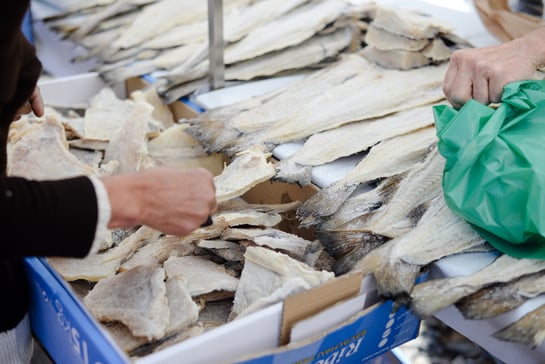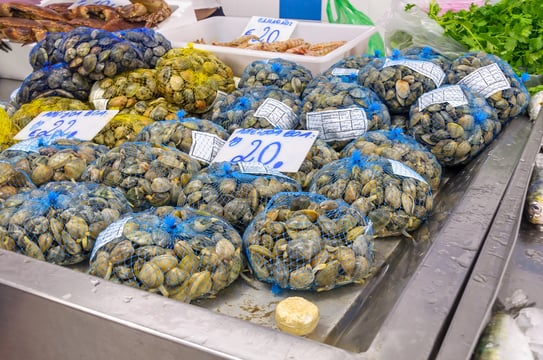With almost 1000 km of coast (not even counting the islands) and at 200 km wide, it’s only natural that Portuguese cuisine contains an abundance of fish dishes. We are, after all, the country that eats the most fish per capita in Europe! The most emblematic Portuguese fish is bacalhaucod , which has been part of our history since the 16th century, during the first voyages of Portuguese sailors that took them to Newfoundland.
Popular Types of Portuguese Fish

Bacalhau salgadoSalted cod is the preferred and best-selling cod fish in Portugal, but it’s also possible to find fresh or frozen cod in the supermarket. You can buy it whole or ask for it to be cut into smaller pieces. Before cooking, it is necessary to soak the cod in water to remove the salt, and you have to change the water a few times. We can guarantee that it is well worth the extra work, since the conservation process reflects positively in the taste of the fish.
SardinhasSardines and carapauhorse mackerel (also known by the name chicharrohorse mackerel ) are two other species with a great tradition in Portugal. The first is strongly associated with summer festivities and saints’ celebrations.
MariscoShellfish is also popular, with the typical arroz de mariscoshellfish rice being considered our favorite shellfish dish.
The shellfish category includes moluscosmollusks and crustáceoscrustaceans . Further on, we will give examples of species belonging to each of these categories.
More of the Most Common Fish:
- pescadahake , robalobass , and douradasea bream
- petingassmall sardines and jaquinzinhossmall, young mackerels (usually deep-fried and served with tomato rice)
- atumtuna and salmãosalmon (commonly found in supermarkets)
Others:
- caçãosandbar shark espadarteswordfish pescadinhasmall hake
- percaperch tamborilmonkfish sávelshad
- chernegrouper pargodentex corvina
- peixe galojohn dory xaputaAtlantic pomfret linguadosole raiaray
- safioskate cavalamackerel peixe-espadalargehead hairtail
- lampreiaslampreys and enguiaseels are two freshwater fish that are also popular in certain regions of the country
Mollusks
The most popular moluscomollusk is o polvooctopus , followed by lulassquids and chocoscuttlefish . Sometimes, instead of polvo, restaurantes will serve dishes with potahumboldt squid which is similar in taste and texture.
Bivalves
The most popular bivalves in Portugal are: mexilhãomussels , amêijoasclams , berbigãocockles , plus the slightly more expensive, and dangerous to catch, percevesgoose neck barnacles (also spelled percebes ).
Other include:
- conquilhasbarnacales
- ostrasoysters
- búzioswhelks
- lapaslimpets
- lingueirãorazor clam (also known as navalhasrazor blades )
Crustaceans
In the crustáceoscrustaceans category, we commonly find camarãoshrimp , gambasprawns , and camarão tigretiger prawn .
Certain crustaceans are often present in big celebrations, especially during Christmas and New Year’s dinners. Those include:
- lagostaspiny lobster , lavagantelobster , and the smaller lagostimlangoustine
- caranguejocrab sapateirabrown crab santolaspider crab
At the Portuguese Fish Market
Where and How Fish are Sold in Portugal
Depending on where they spend their lives, fish can be peixes de água salgadasaltwater fish or peixes de água docefreshwater fish . Nowadays, after being caught by os pescadoresfishermen , the fish are sold “auction style” at the lotawarehouse where fish is sold . Later, they are sold to the public by the famous peixeirasfishmongers at the various praçasmarket squares , or in supermarkets.
You can find peixe frescofresh fish or peixe congeladofrozen fish , peixe de conservacanned fish or peixe salgadosalted fish . You may see the terms aquaculturaaquaculture or selvagemwild on the labels. Salmon, for example, often has the aquacultura tag, while the term selvagem is often associated with shrimp.
Ordering Fish at the Market

The Basics
There are many ways you can ask for the fish you want to take home and cook. For example, if you know how to choose fish, you can directly tell the fishmonger: Queria aquele robalo aliI would like that bass there
Otherwise, you can just say:
Queria um robaloI would like a bass
With certain fish, you can use larger numbers:
Quero uma dúzia de sardinhasI want a dozen sardines
With smaller fish and bivalves, you ask for them by weight:
Quero meio quilo de amêijoasI want half a kilo of clams
Cleaning and Preparing the Fish
Once you have chosen the fish and the quantity of it that you want, you can ask them to arranjarem o peixefix the fish , which is, basically, removing the scales and cleaning the guts. Limpar o peixeClean the fish is another way of phrasing it. This process is also known as amanhar o peixecleaning the fish , so we say the fish foi amanhadowas cleaned – that is, it’s ready for cooking. You use this same expressions with mollusks, also. After choosing the fish, you can then say:
(O peixe) É para arranjar(The fish) is to be cleaned
Depending on the type of fish, you can ask for it to be cut into postasslices .
If they do not ask you, you can also tell them to open the fish as well by saying:
(O peixe) É para escalar(The fish) is to be open
Supermarkets can have loins and fillets of fresh fish for sale, although these are always available in the frozen fish section. The difference between the fillets and the loins is that the first are thinner horizontals cuts while the loins are a larger piece of the fish.
All fish, when arranged, são escamadosare scaled , except for sardines which are normally for roasting on the grill.
Mollusks must also be arranjadoscleaned , by washing and removing certain parts such as the eyes and mouth. In the case of the cuttlefish, some people ask the fishmonger not to clean the insides, therefore keeping the ink of the animal.






Hi
apropos Bacalhao
A few years ago when visiting Portimo for the first time I visited the local supermercado PingoDoce. There I found a huge pile of dried codfish and the box said it was from Nils Sperre, Ålesund. I still have the photo. So I mailed it to my workmate, and she said ‘Gosch, that’s my uncle’. So it is a small world! I am Swedish (Laponia) but has been living most of life in Norway, buy now more and more in Portugal, now near Lisboa, with portuguese neighbors and brazilian woman and her family. And was lucky to find your website in addition to others, Next time I hope to comment in Portuguese, European, but with a Brazilian touch.
Keep up the good work!
Best regards, Hasse
Nice and detailed explanation about fishes. Really good lesson for who lives in Portugal. To the owner of this site I’m requesting you to give super bonus offer for Christmas so I can rejoin this membership. I am waiting to have this offer. Thank You Joe and his team for doing 5his great effort for the new speakers of portuguese. Doing great work for the all and country as well. Nice
I see salmon at the mercado and do not know how to distinguish between the different cuts. How do I ask for a specific cut as opposed to another for fish that is already cleaned and cut? Thanks.
The general choice will be between filetes (fillets) and postas (slices), with some other possibilities, such as lombos (loins) or cubos (cubes). There are different ways you can ask for each, but one example would be “Queria [1/2/3… units or per weight] filetes/postas/lombos/cubos de salmão, se faz favor”.
Thank you! That helps!